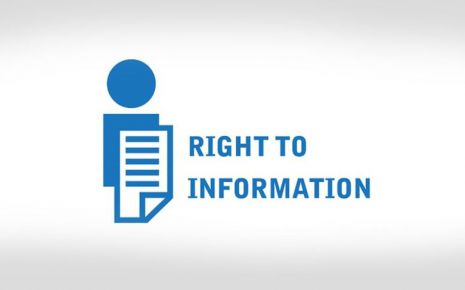Right to Information Act, 2005 - A weapon against Corruption
For the purpose of providing impetus to Accountability and Transparency, the
Parliament of India enacted the Right to Information Act 2005, which came into
force on the 12th of October, 2005.
The Right to Information Act enables the citizens of India to inquire and seek information from a Public Authority, thereby making the Government and its functionaries liable for its affairs and the institution is required by law to reply immediately or under thirty days of filing of the application. If in any case the information required affects the life and liberty of another person, the information sought must be provided within forty eight hours.
The Act seeks to provide a practical domain for the right to seek information of the citizens. The Act also requires the public authorities to compile a computerized record of the same for wide dissemination and references and to proactively ascertain the categories of information for the purpose of minimalizing the efforts made by the public to formally request the information.
Applicability of the Act.
The Act covers the whole of India including all Union Territories as well as the State of Jammu and Kashmir.
The Act thereby covers:
Every day on an average, over 4800 RTI applications are filed. In the first ten years of the commencement of the Act, over 17,500,000 applications had been filed. It guards the fundamental rights to Freedom of Expression and Speech under Article 19(1) (a) and Right to Life and Personal Liberty under Article 21 guaranteed by the Constitution of India.
The authorities under the Act are Public Authorities. The Public Information Officer (PIO) or the First Appellate Authority perform Quasi-Judicial function of determining the application and appeal respectively. This Act was enacted in order to amalgamate the fundamental right of 'Freedom of Speech' in the Indian Constitution. Since RTI is ingrained in the Right to Freedom of Speech and Expression under Article 19 of the Constitution, it is an implied fundamental right.
In India, illiteracy becomes a huge barrier for people especially when it comes to filing for applications under the RTI Act. Most of these people come from under-privileged backgrounds and had often been victims of corruptive or malicious intentions. In light of such issues, young and brilliant of the country have come forward to solve such issues by proactively helping such people in exercising their right to freedom of information and being a beacon of hope for a better, more accountable system of governance.
The work of RTI activists have help to bring the a significant number of corrupt people under the ambit of judicial review and has helped people realize the true meaning of the sentence Government of the people, by the people, for the people
The applications filed by RTI activists like Yogacharya Anandji and Simpreet Singh in 2008 were influential in exposing links between politicians and military officials, among others.
Exceptions.
Notwithstanding any provision(s) contained in the Right to Information Act 2005, there are certain specified exceptions to the Act. Section 8 of the RTI Act elaborates on the exceptions:
For determining whether the requested information is to be withheld in any situation, it has to be subjected through a series of questions.
Online Method:
The online method makes it easy to file RTIs and also makes it easier to appeal against the order on such application. This service, for now, is only available for Central Government Departments and Ministries including the PMO, the Secretariat of the President and the Vice-President and Lok Sabha and Rajya Sabha Secretariat.
The following steps will have to be undertaken:
Offline Method:
After the enforcement of the RTI Act, 2005, Social Activists, Civil Society Organizations, and Ordinary Citizens Organizations have effectively used the Act against corruption in the interest of the public. In the light of such circumstances, there are a number of cases which have seen judicial review:
Adarsh Society Scam:
A six-storey building for the widows of Kargil war heroes, turned into a 31-storey high-rise called Adarsh Housing Society. Located in Mumbai's posh residential area Colaba, it soon became the abode of politicians, bureaucrats, and top military officers. The nexus was exposed by RTI activists Simpreet Singh and Yogacharya Anandji.
23,000 loan fraud cases in past 5 years: Replying to an RTI, the Reserve Bank of India (RBI) had informed that 23,000 cases of fraud have been reported by various banks in the past five years, which involved Rs.1 lakh crore.
Conclusion:
The Act seeks to provide a practical domain for the right to seek information of the citizens. The Act also requires the public authorities to compile a computerized/digitalized record of the same for wide dissemination and references and to proactively ascertain the categories of information for the purpose of minimalizing the efforts made by the public to formally request the information.
The Right to Information Act enables the citizens of India to inquire and seek information from a Public Authority, thereby making the Government and its functionaries liable for its affairs and the institution is required by law to reply immediately or under thirty days of filing of the application. If in any case the information required affects the life and liberty of another person, the information sought must be provided within forty eight hours.
The Act seeks to provide a practical domain for the right to seek information of the citizens. The Act also requires the public authorities to compile a computerized record of the same for wide dissemination and references and to proactively ascertain the categories of information for the purpose of minimalizing the efforts made by the public to formally request the information.
Applicability of the Act.
The Act covers the whole of India including all Union Territories as well as the State of Jammu and Kashmir.
The Act thereby covers:
- Central, State and local governments and all bodies owned, controlled, or substantially financed by the respective governments [Section 2(h)]
- Non-Government Organizations substantially financed directly or indirectly by funds provided by the appropriate government [Section 2(e)]
- The Legislative, Executive and Judiciary and and includes information relating to private body which can be accessed under any other law for the time being in force. [Section 2(f)]
- Information refers to any material in any form including Records, Documents, Memos, Opinions, Advices, Press Releases, Circulars, Orders, Long-books, Contracts, Reports, Papers, samples, models and data held in any electronic form.
- Public Authority also includes any authority or body or institution established by/under the Constitution of India, an Act of Parliament, Act of State Legislature.
Significance of the RTI Act 2005 and its Impact on the Society
The RTI Act 2005 if often upheld as a legislation that has the power to transform the manner in which government institutions operate. It is undoubtedly one of the strongest legislative tools in the hands of a citizen. In a positive way, it brings more transparency and accountability to the system and keeps malicious and corrupt practices in check. The foundation of the RTI Act emanates from three major sources which include, The Principles of Natural Justice, Instruments of Human Rights, and the Constitution of India (Fundamental Rights).Every day on an average, over 4800 RTI applications are filed. In the first ten years of the commencement of the Act, over 17,500,000 applications had been filed. It guards the fundamental rights to Freedom of Expression and Speech under Article 19(1) (a) and Right to Life and Personal Liberty under Article 21 guaranteed by the Constitution of India.
The authorities under the Act are Public Authorities. The Public Information Officer (PIO) or the First Appellate Authority perform Quasi-Judicial function of determining the application and appeal respectively. This Act was enacted in order to amalgamate the fundamental right of 'Freedom of Speech' in the Indian Constitution. Since RTI is ingrained in the Right to Freedom of Speech and Expression under Article 19 of the Constitution, it is an implied fundamental right.
Role of RTI Activists
RTI Activist is a person who uses Right to Information Act 2005, to get the various information from Public Authorities. Anyone, who is a graduate, can be instrumental in the fight against corruption by being an RTI activist.In India, illiteracy becomes a huge barrier for people especially when it comes to filing for applications under the RTI Act. Most of these people come from under-privileged backgrounds and had often been victims of corruptive or malicious intentions. In light of such issues, young and brilliant of the country have come forward to solve such issues by proactively helping such people in exercising their right to freedom of information and being a beacon of hope for a better, more accountable system of governance.
The work of RTI activists have help to bring the a significant number of corrupt people under the ambit of judicial review and has helped people realize the true meaning of the sentence Government of the people, by the people, for the people
The applications filed by RTI activists like Yogacharya Anandji and Simpreet Singh in 2008 were influential in exposing links between politicians and military officials, among others.
Exceptions.
Notwithstanding any provision(s) contained in the Right to Information Act 2005, there are certain specified exceptions to the Act. Section 8 of the RTI Act elaborates on the exceptions:
- Information, disclosure of which would prejudicially affect the security, sovereignty and integrity of India;
- Information which may constitute contempt of court;
- Information that would cause a breach of privilege of Parliament or the State Legislature;
- Information including commercial confidence, trade secrets or intellectual property, the disclosure of which would harm the competitive position of a third party, unless the competent authority is satisfied that larger public interest warrants the disclosure of such information;
- Information available to a person in his fiduciary relationship, unless the competent authority is satisfied that the larger public interest warrants the disclosure of such information;
- Information received in confidence from foreign government;
- Information, the disclosure of which would endanger the life or physical safety of any person;
- Information which would impede the process of investigation or apprehension or prosecution of offenders;
- Cabinet papers including records of deliberations, which come under the specified exemptions;
- Information which associates with personal information, the disclosure of which, has no link to any public activity or interest, or which would result in unwarranted invasion of privacy.
For determining whether the requested information is to be withheld in any situation, it has to be subjected through a series of questions.
- Firstly, is the information covered under a legitimate exception?
- Secondly, will the disclosure of the information cause any harm to the integrity and sovereignty of the nation?
- Thirdly, is the likely harm greater than the public interest in disclosure?
Step-wise process to file an RTI Application
Currently there are two ways to file an RTI Application.- Online Method
- Offline Method
Online Method:
The online method makes it easy to file RTIs and also makes it easier to appeal against the order on such application. This service, for now, is only available for Central Government Departments and Ministries including the PMO, the Secretariat of the President and the Vice-President and Lok Sabha and Rajya Sabha Secretariat.
The following steps will have to be undertaken:
- Identification of the department from where the information is sought. The respective website of the department or a quick research in order to make sure you file the application with the right department.
- Visit http://rtionline.gov.in. On the Home-Page of the website, there is an option for the login of Registered Users. Registration is not mandatory, one can choose to register or move directly to the Submit Request option.
- Click on the Submit Request tab and go through the guidelines for the use of the RTI online portal. Once done, click on the I have read and understood the above guideline checkmark and click on Submit.
- Filling out the form. The form consists of the options to choose the department of the central government and the public authority. In the Text for RTI Request application text box one needs to provide the questions about the subject upon which the information is sought.
- The form is not processed until the payment is made. A nominal fee of INR 10 needs to be paid, which can be done through a credit or debit card, or through internet banking.
- Once the payment is made a Registration ID along with the receipt is provided. The receipt has to be kept for future reference. The Registration ID will provide access to the application and the reply.
Offline Method:
- Identification of the government (Central/State) and the authority from the information is sought.
- Once the above step is complete, one needs to address an application on a white sheet of paper to the Public Information Officer of such authority or department, followed by the name and address of the department.
- In the Subject line of the application mention this line Seeking Information under the RTI Act, 2005.
- Enlist all such points in the form of questions upon which the information is sought including details for specific information such as dates and years.
- Once the application is complete, mention the date of the application and the details of the postal order of Rupees 10 which needs to be attach along with the application. Also, the people below poverty line are not required to attach the postal order or make the fee payment, but they must attach a copy of the BPL Certificate.
- Sign the Application form, full name and address along with the date and send it through a registered post to the office of the concerned authority.
- If a reply is not received within 30 days, an appeal can be filed with the Appellate Authority.
RTI as weapon against Corrupt Practices with recent cases:
Corruption is a problem that undermines transparency in the governance system and accountability of citizens but with every problem there is always a solution and that is, Right to Information.After the enforcement of the RTI Act, 2005, Social Activists, Civil Society Organizations, and Ordinary Citizens Organizations have effectively used the Act against corruption in the interest of the public. In the light of such circumstances, there are a number of cases which have seen judicial review:
Adarsh Society Scam:
A six-storey building for the widows of Kargil war heroes, turned into a 31-storey high-rise called Adarsh Housing Society. Located in Mumbai's posh residential area Colaba, it soon became the abode of politicians, bureaucrats, and top military officers. The nexus was exposed by RTI activists Simpreet Singh and Yogacharya Anandji.
23,000 loan fraud cases in past 5 years: Replying to an RTI, the Reserve Bank of India (RBI) had informed that 23,000 cases of fraud have been reported by various banks in the past five years, which involved Rs.1 lakh crore.
Conclusion:
The Act seeks to provide a practical domain for the right to seek information of the citizens. The Act also requires the public authorities to compile a computerized/digitalized record of the same for wide dissemination and references and to proactively ascertain the categories of information for the purpose of minimalizing the efforts made by the public to formally request the information.
Law Article in India
Legal Question & Answers
Lawyers in India - Search By City
LawArticles
How To File For Mutual Divorce In Delhi

How To File For Mutual Divorce In Delhi Mutual Consent Divorce is the Simplest Way to Obtain a D...
Increased Age For Girls Marriage

It is hoped that the Prohibition of Child Marriage (Amendment) Bill, 2021, which intends to inc...
Facade of Social Media

One may very easily get absorbed in the lives of others as one scrolls through a Facebook news ...
Section 482 CrPc - Quashing Of FIR: Guid...

The Inherent power under Section 482 in The Code Of Criminal Procedure, 1973 (37th Chapter of t...
The Uniform Civil Code (UCC) in India: A...

The Uniform Civil Code (UCC) is a concept that proposes the unification of personal laws across...
Role Of Artificial Intelligence In Legal...

Artificial intelligence (AI) is revolutionizing various sectors of the economy, and the legal i...





Please Drop Your Comments